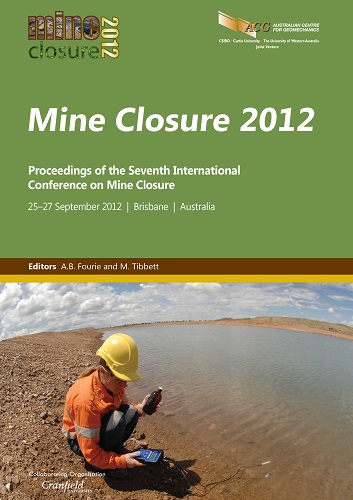Critical analysis and mine closure: why do things still go wrong in a swirl of feasibility, regulation and planning?

|
Authors: Haymont, R |
DOI https://doi.org/10.36487/ACG_rep/1208_05_Haymont
Cite As:
Haymont, R 2012, 'Critical analysis and mine closure: why do things still go wrong in a swirl of feasibility, regulation and planning?', in AB Fourie & M Tibbett (eds), Mine Closure 2012: Proceedings of the Seventh International Conference on Mine Closure, Australian Centre for Geomechanics, Perth, pp. 39-48, https://doi.org/10.36487/ACG_rep/1208_05_Haymont
Abstract:
Mine closure planning is attended by increasingly more comprehensive regulatory, technical, corporate and financial planning requirements. However, in some parts of the mining sector in Australia, there are very significant areas of mining disturbance that clearly cannot be relinquished. Further, proposals in the process of approval do not suggest that many of the new developments in these areas will perform significantly better. This paper investigates how this can continue to be the case, when increasing focus continues to be applied to mine closure. Although some of the contributing factors discussed are technical, such as climatic, chemical and physical conditions, modelling and design, several are more centred on corporate, organisational, regulatory and essentially human attributes. These factors frequently involve obstacles to critical analysis that make mine closure predisposed to a failure to meet closure expectations and commitments. These contributing factors are often largely ignored in the processes attendant to understanding long-term mining liability during due diligence, feasibility, approvals, operations and the closure phase. Identifying instances where a number of such factors may be present can indicate that some risks may not be captured in technical risk assessments. In addition to detailing several of the contributing factors which can lead to a failure of mine closure or mine closure planning, this paper proposes mitigating responses for each of the contributing factors presented and expands upon responses which have the greatest probability of being adopted.
© Copyright 2025, Australian Centre for Geomechanics (ACG), The University of Western Australia. All rights reserved.
View copyright/legal information
Please direct any queries or error reports to repository-acg@uwa.edu.au
View copyright/legal information
Please direct any queries or error reports to repository-acg@uwa.edu.au